California
Tech billionaires postpone their plan for a new California city
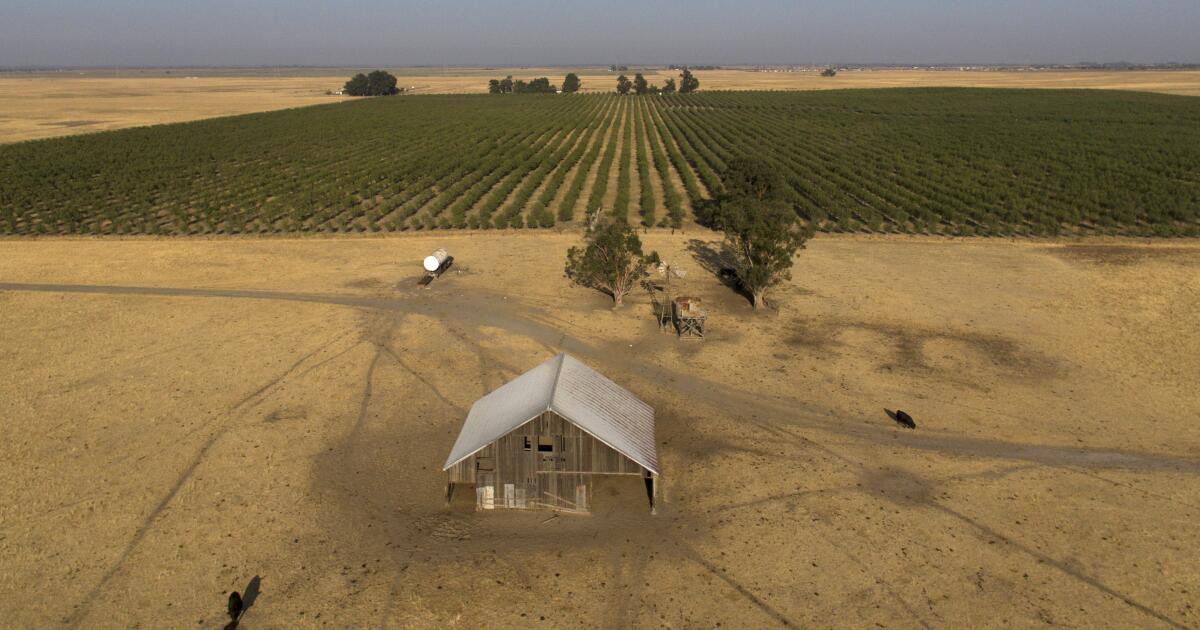
Good morning. It’s Thursday, July 25. Here’s what you need to know to start your day.
Plans for a new California city are halted. Can trust be rebuilt?
A billionaires-backed plan to build a city from scratch in rural Solano County had been slated to go before the region’s voters in November.
But on Monday, county leaders and the initiative’s architect announced an agreement to pull it from the ballot.
The group, called California Forever, says it will now go through the usual multiyear process for would-be developments, which involves applying for necessary rezoning, conducting an environmental impact report and reaching a development agreement with the county.
An artist’s rendering of a neighborhood. Backers who want to build a green city from scratch began with secretive land purchases in Solano County.
(Sitelab Urban Studio / CMG)
The county and aspiring developers framed the decision as a chance to pause and reset after years of secrecy and mistrust. But critics say the tech billionaires’ vision is an ill-conceived plan that would do more harm than good.
First, a refresher
We first brought you the mysterious story of California Forever in August when a secretive limited liability company that spent about $800 million to purchase more than 52,000 acres in Solano County was revealed to be an ambitious project by Silicon Valley elites.

Proponents of the project used a limited liability company to buy up land from farmers in a vast swath of the county, stretching from Rio Vista, pictured, to the west, without telling anyone why.
(Godofredo A. Vásquez / Associated Press)
Their pitch: Build a new California city fueled by clean energy and filled with affordable housing and good-paying jobs. The plan is the brainchild of Jan Sramek, a former Goldman Sachs trader, who framed it as vital to boost California’s dismal housing supply and keep the state competitive as jobs and renewable energy move elsewhere.
Investors in the project include billionaire investor Michael Moritz, Emerson Collective founder Laurene Powell Jobs, LinkedIn co-founder Reid Hoffman and venture capitalist Marc Andreessen.
Once they were outed, the group changed its approach, initially dubbing its plan California Forever (with renderings that appeared to have been hastily created with artificial intelligence) before rebranding to the East Solano Plan. The group began gathering signatures to get a ballot measure before local voters in November that would change zoning rules, bypassing the typical process.
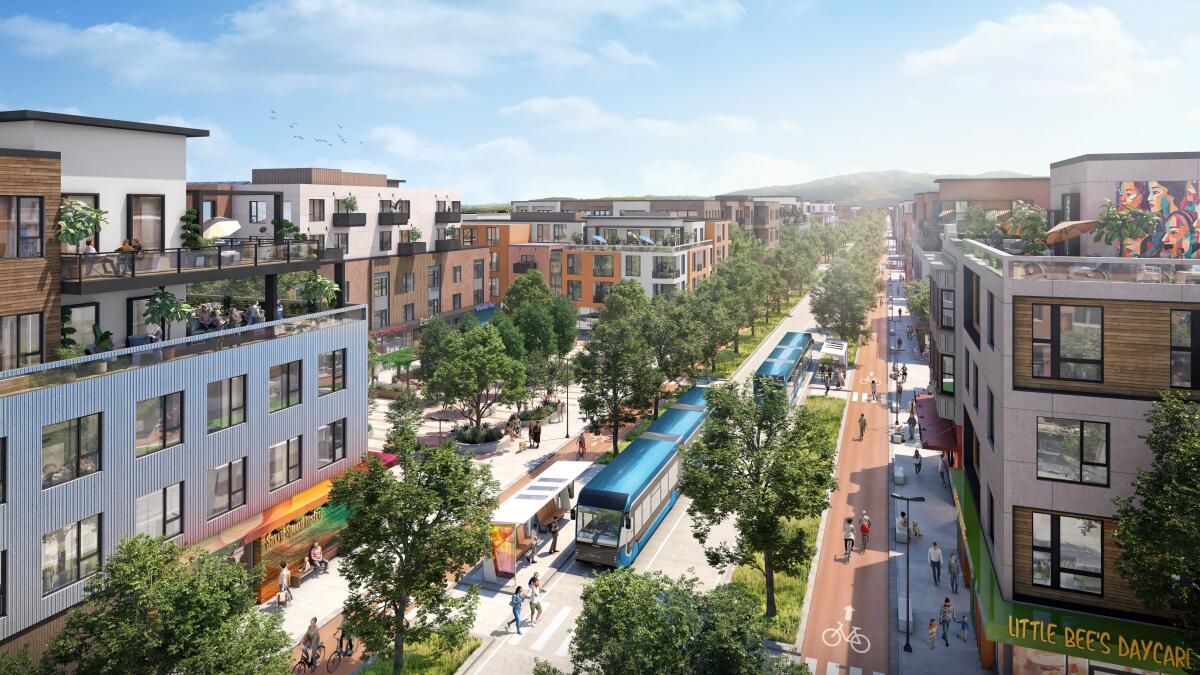
An artist’s rendering of a neighborhood in a proposed city in Solano County.
(Sitelab Urban Studio)
Going that route “was a mistake,” Mitch Mashburn, chair of the Solano County Board of Supervisors, wrote in the joint statement. “This politicized the entire project, made it difficult for us and our staff to work with them, and forced everyone in our community to take sides.”
The group’s lack of transparency and accusations of heavy-handed tactics rubbed many politicians and residents the wrong way. They also sued farmers in federal court, which further incensed residents and elected leaders.
Speaking during a Tuesday meeting, Solano County Supervisor Monica Brown said that California Forever “operated in bad faith” and that she “will never trust anything that they bring forward.”
“Go somewhere else,” Brown said. “There’s 57 other counties. They might want you and your money.”
Critics say the plan is the wrong approach
Local opposition to the project has been swift and vocal, with some noting it breaks the prime rule of real estate: location, location, location. Critics point to the lack of road infrastructure, access to water and public transit.
“It is a huge waste of private and public resources to develop a new city in this location,” said Sadie Wilson, director of planning and research at Greenbelt Alliance. The nonprofit advocates for climate resiliency in Bay Area counties and is part of the Solano Together Coalition.
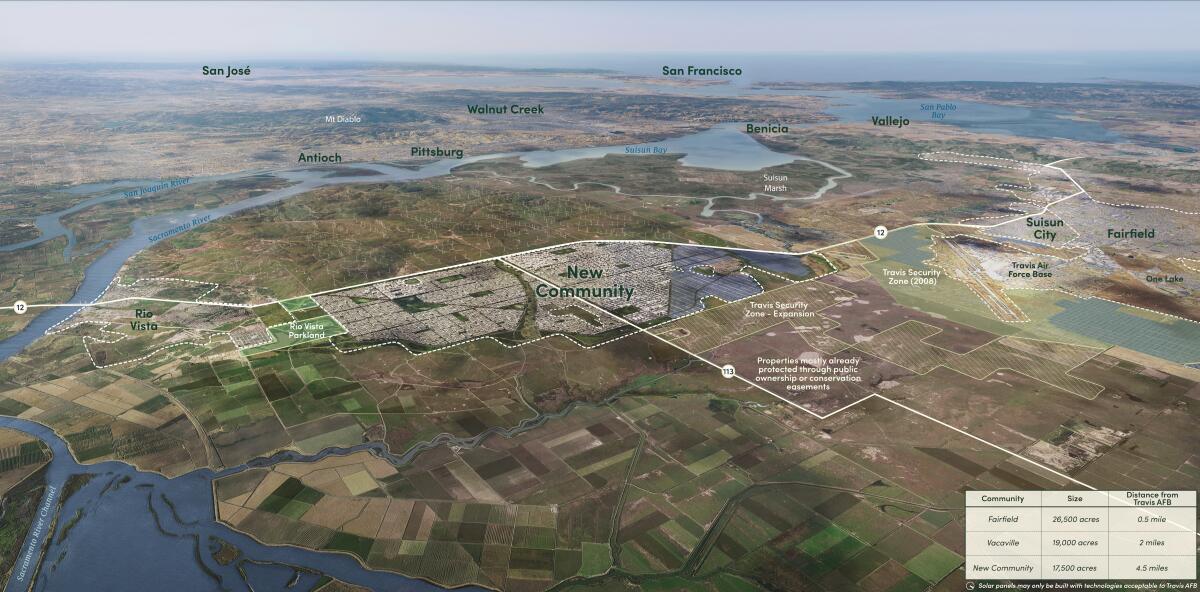
An aerial rendering of where the planned community by California Forever would fit into Solano County.
(California Forever)
Members have been focused on getting accurate information to voters about the East Solano Plan, Wilson told me, but are also cultivating an “alternative vision” for prosperity in the region that doesn’t rely on billionaires.
Wilson said the plan “flies in the face” of both climate resiliency and housing goals, which would be better served by strategically expanding housing in existing cities. Building the schools, roads, sewer systems and other infrastructure to accommodate the more than 500,000 people California Forever hopes would live in its new city would cost a lot — both in dollars and emissions.
The county commissioned a consultant’s report for the project, which found that creating the necessary infrastructure would cost tens of billions and generate well over 2 billion new vehicle miles traveled (the state meanwhile is working to reduce how much Californians drive).
What’s next?
In that joint statement, Sramek said his group will work with the county “to build a shared vision” and plans to “bring the full package back for approval in 2026.”
“We want to show that it’s possible to move faster in California,” he wrote in a statement.
“But we recognize now that it’s possible to reorder these steps without impacting our ambitious timeline.”
Mashburn acknowledged Sramek for his understanding and optimism, but also issued him a challenge:
“Use the Environmental Impact Report and Development Agreement process to prove to us how you’ll strengthen Travis AFB, how you’ll provide water, and how you will solve the transportation challenges. And show us the financial engineering that makes it possible to pay for billions of dollars of infrastructure, without increasing our taxes, and while delivering a net tax surplus to our county.”
California Forever’s decision to pull the ballot measure was “a major win” for the coalition, Wilson told me.
“They just backed out of this initiative because they knew they weren’t going to win,” she said, adding that she hopes the group will be more transparent about their endgame if they’re serious about mending things with county leaders and residents.
“It’s hard to come back from that lack of trust and that deception,” she said. But “this is certainly not over.”
Today’s top stories
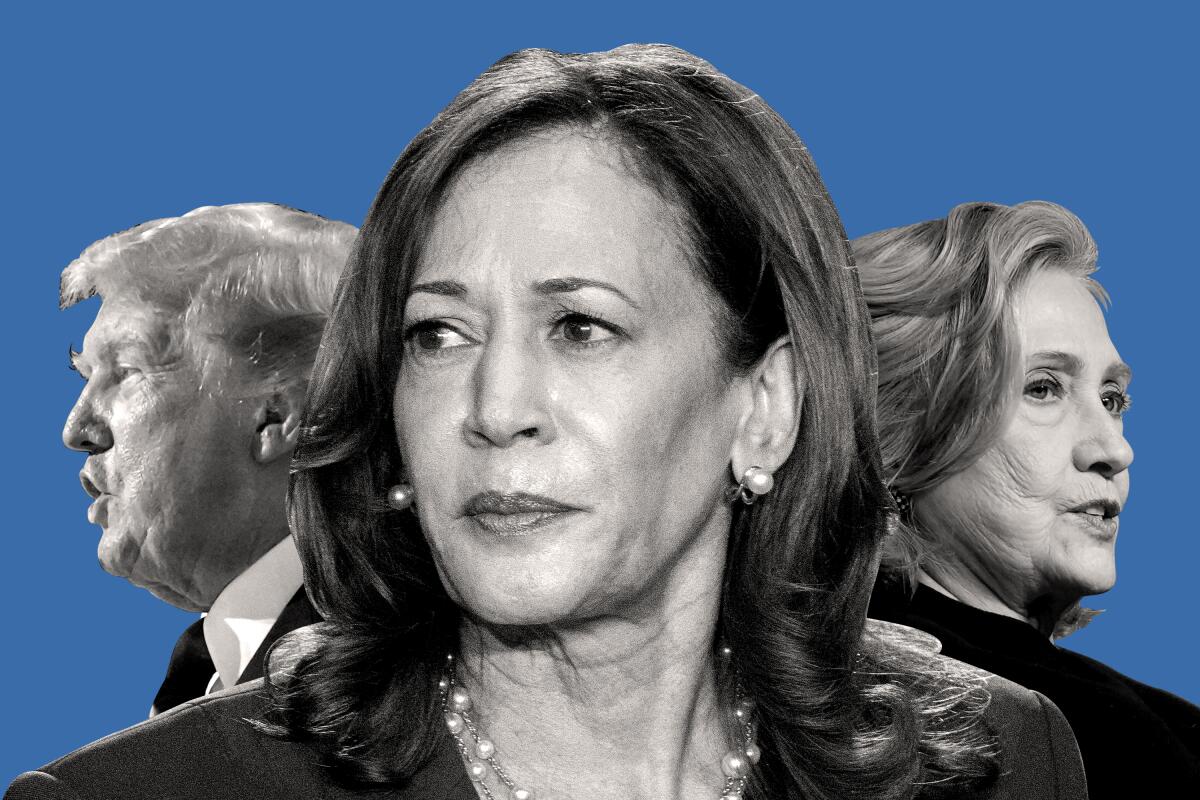
(Los Angeles Times photo illustration; Photos via AP Photo)
Kamala Harris
Homelessness
Extreme weather is on the move
The 2024 Summer Olympics start tomorrow!
Say hello to the Hydrogen Hub
Pro-Palestinian campus protests
UCLA Fowler Museum’s stolen artifacts
More big stories
Get unlimited access to the Los Angeles Times. Subscribe here.
Today’s great reads

Chris Kraus for Image.
(Arielle Bobb-Willis / For The Times)
L.A. legend Chris Kraus is finding answers in her sleep, and she’s not looking back. Chris Kraus and Catherine Lacey, two writers of two generations, talk mixing genres, daily schedules and the critics.
Other great reads
How can we make this newsletter more useful? Send comments to essentialcalifornia@latimes.com.
For your downtime

Andrew Chaves, director of operations at Rancho Los Alamitos Historic Ranch and Gardens in Long Beach, stands next to a preformed pond that he and his wife, Amanda, dug into the ground.
(Jeanette Marantos/Los Angeles Times)
Going out
And finally … from our archives
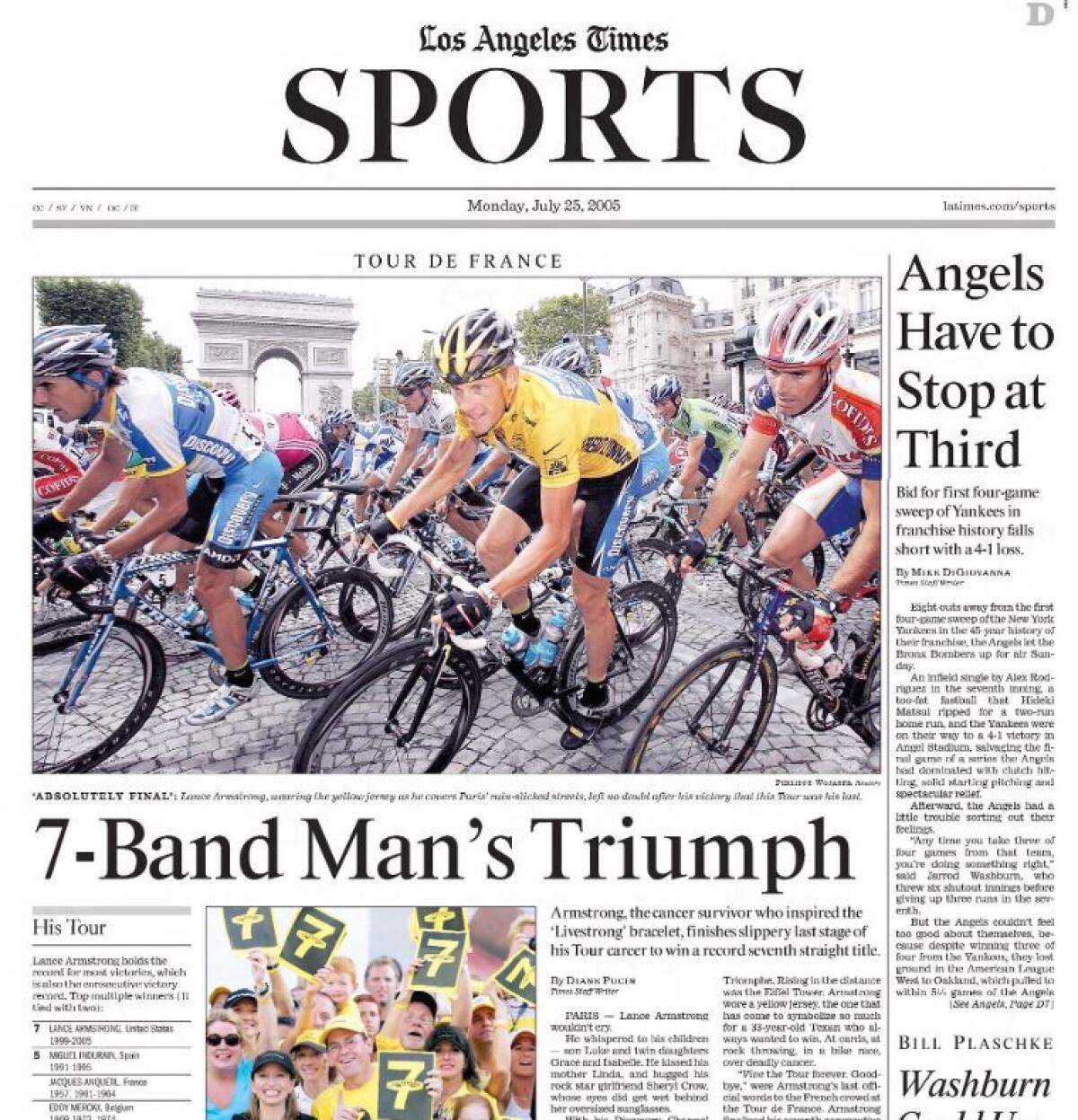
On this day in history, Lance Armstrong finalized his seventh consecutive Tour de France win. He was later stripped of the titles.
Have a great day, from the Essential California team
Ryan Fonseca, reporter
Defne Karabatur, fellow
Andrew Campa, Sunday reporter
Kevinisha Walker, multiplatform editor and Saturday reporter
Christian Orozco, assistant editor
Stephanie Chavez, deputy metro editor
Karim Doumar, head of newsletters
Check our top stories, topics and the latest articles on latimes.com.

California
California wants Verizon to compromise more on DEI

California
California governor race heats up with uncertainty and potential surprises

BAKERSFIELD, Calif. (KBAK/KBFX) As the race for California’s next governor intensifies, uncertainty looms with the primary election just six months away.
A recent Emerson College poll shows Republican Chad Bianco leading by a narrow margin of one point, while 31% of voters remain undecided.
“The field remains wide open,” said Tal Eslick, owner of Vista Consulting. “There’s a half dozen credible Democrats in the race. There’s really a couple – two – namely Republicans.”
Eslick noted that Bianco’s lead is more reflective of the crowded Democratic field than a shift toward Republicans statewide.
California governor race heats up with uncertainty and potential surprises (Photo: AdobeStock)
He suggested a “black horse candidate” could still emerge, possibly from Hollywood or outside politics.
With rising energy and gas prices, affordability is expected to be a key issue for voters.
California governor race heats up with uncertainty and potential surprises (AP Photo/Juliana Yamada, File)
“I think that you could also see voters vote with their pockets,” Eslick said, highlighting the potential for a non-traditional candidate to gain traction.
California
California threatens Tesla with 30-day suspension of sales license for deceptive self-driving claims
SAN FRANCISCO — California regulators are threatening to suspend Tesla’s license to sell its electric cars in the state early next year unless the automaker tones down its marketing tactics for its self-driving features after a judge concluded the Elon Musk-led company has been misleading consumers about the technology’s capabilities.
The potential 30-day blackout of Tesla’s California sales is the primary punishment being recommended to the state’s Department of Motor Vehicles in a decision released late Tuesday. The ruling by Administrative Law Judge Juliet Cox determined that Tesla had for years engaged in deceptive marketing practices by using the terms “Autopilot” and “Full Self-Driving” to promote the autonomous technology available in many of its cars.
After presiding over five days of hearings held in Oakland, California in July, Cox also recommended suspending Tesla’s license to manufacture cars at its plant in Fremont, California. But California regulators aren’t going to impose that part of the judge’s proposed penalty.
Tesla will have a 90-day window to make changes that more clearly convey the limits of its self-driving technology to avoid having its California sales license suspended. After California regulators filed its action against Tesla in 2023, the Austin, Texas, company already made one significant change by putting in wording that made it clear its Full Self-Driving package still required supervision by a human driver while it’s deployed.
“Tesla can take simple steps to pause this decision and permanently resolve this issue — steps autonomous vehicle companies and other automakers have been able to achieve,” said Steve Gordon, the director of the California Department of Motor Vehicles.
Tesla didn’t immediately respond to a request for comment Wednesday.
The automaker has already been plagued by a global downturn in demand that began during a backlash to Musk’s high-profile role overseeing cuts in the U.S. government budget overseeing the Department of Government that President Donald Trump created in his administration. Increased competition and an older lineup of vehicles also weighed on Tesla sales, although the company did revamp its Model Y, the world’s bestselling vehicle, and unveil less-expensive versions of the Model Y and Model X.
Although Musk left Washington after a falling out with Trump, the fallout has continued to weigh on Tesla’s auto sales, which had decreased by 9% from 2024 through the first nine months of this year.
Despite the slump and the threatened sales suspension in California, Tesla’s stock price touched an all-time high $495.28 during Wednesday’s early trading before backtracking later to fall below $470. Despite that reversal, Tesla’s shares are still worth slightly more than they were before Musk’s ill-fated stint in the Trump administration — a “somewhat successful” assignment he recently said he wouldn’t take on again.
The performance of Tesla’s stock against the backdrop of eroding auto sales reflects the increasing emphasis that investors are placing on Musk’s efforts to develop artificial intelligence technology to implant into humanoid robots and a fleet of self-driving Teslas that will operate as robotaxis across the U.S.
Musk has been promising Tesla’s self-driving technology would fulfill his robotaxi vision for years without delivering on the promise, but the company finally began testing the concept in Austin earlier this year, albeit with a human supervisor in the car to take over if something went awry. Just a few days ago, Musk disclosed Tesla had started tests of its robotaxis without a safety monitor in the vehicle.
California regulators are far from the first critic to accuse Tesla of exaggerating the capabilities of its self-driving technology in a potentially dangerous manner. The company has steadfastly insisted that information contained in its vehicle’s owner’s manual on its website have made it clear that its self-driving technology still requires human supervision, even while releasing a 2020 video depicting one of its cars purportedly driving on its own. The video, cited as evidence against Tesla in the decision recommending a suspension of the company’s California sales license, remained on its website for nearly four years.
Tesla has been targeted in a variety of lawsuits alleging its mischaracterizations about self-driving technology have lulled humans into a false of security that have resulted in lethal accidents. The company has settled or prevailed in several cases, but earlier this year a Miami jury held Tesla partly responsible for a lethal crash in Florida that occurred while Autopilot was deployed and ordered the automaker to pay more than $240 million in damages.
-

 Iowa4 days ago
Iowa4 days agoAddy Brown motivated to step up in Audi Crooks’ absence vs. UNI
-

 Washington1 week ago
Washington1 week agoLIVE UPDATES: Mudslide, road closures across Western Washington
-

 Iowa5 days ago
Iowa5 days agoHow much snow did Iowa get? See Iowa’s latest snowfall totals
-

 Maine2 days ago
Maine2 days agoElementary-aged student killed in school bus crash in southern Maine
-

 Maryland4 days ago
Maryland4 days agoFrigid temperatures to start the week in Maryland
-

 Technology1 week ago
Technology1 week agoThe Game Awards are losing their luster
-

 South Dakota4 days ago
South Dakota4 days agoNature: Snow in South Dakota
-

 Nebraska1 week ago
Nebraska1 week agoNebraska lands commitment from DL Jayden Travers adding to early Top 5 recruiting class


















